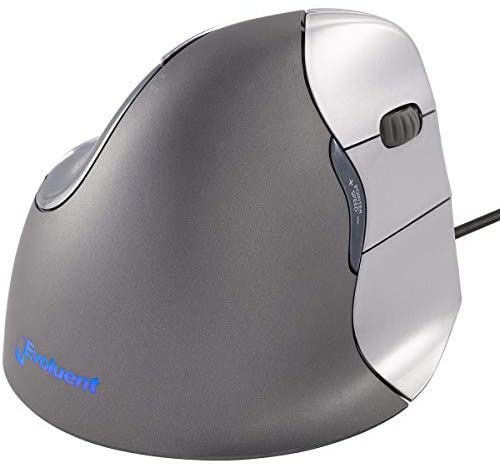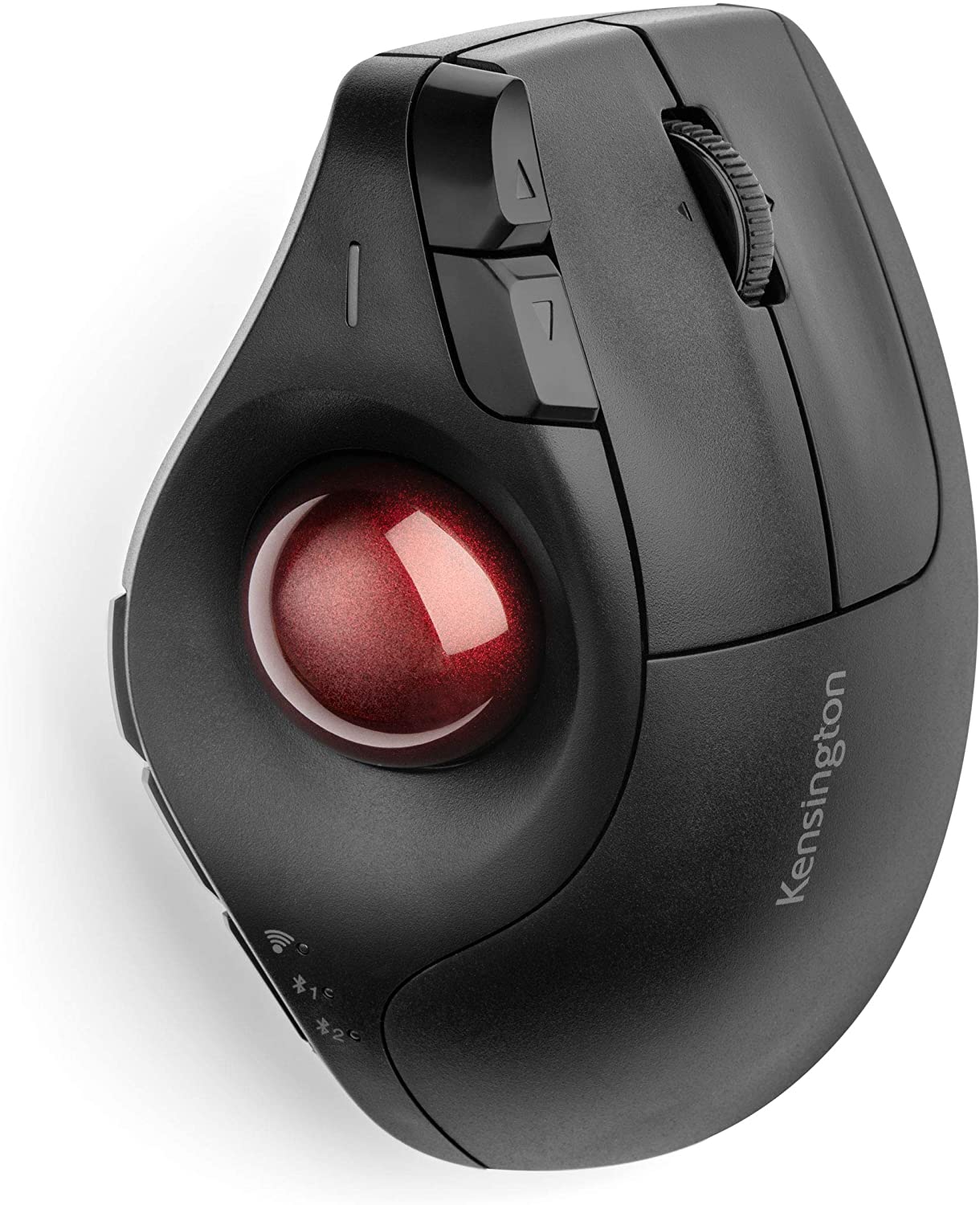The Best Vertical Mouse for Your Money
A vertical mouse can help reduce wrist strain by promoting a more natural hand position while you’re gaming or working at a computer.
Unlike a traditional computer mouse, which requires you to twist the arm and wrist, a vertical mouse is ergonomically shaped so that you can hold it in the same position as if you were shaking someone’s hand or holding a cup.
According to some experts, this “handshake” position can relieve pain resulting from conditions such as carpal tunnel syndrome and possibly reduce the risk of more serious damage in the long run. Because your wrist remains in a neutral position while using a vertical mouse, it can also be more comfortable, even though it might take time to get used to it.
“Ergonomic” sometimes means expensive, but there’s no need to break the bank to get a good vertical mouse. There are many models between $20 and $30, only slightly more than traditional mice. Some high-end vertical mouse models, however, can cost upwards of $100.
Vertical Mouse Buying Guide
Here are some factors to consider when shopping for a vertical mouse.
• Connectivity. Just like regular mice, vertical mice can connect to your computer in one of three ways: by wire, Bluetooth or USB receiver (a tiny plug that connects to your computer’s USB port allowing for wireless connection with compatible devices).
Each type has its advantages and disadvantages. Wired mice are typically faster, more responsive and don’t require batteries, but the cable might be limiting.
On the other hand, wireless mice give you the freedom to move them across your desk without constraint. However, they sometimes lag in responsiveness, are less sensitive compared to wired models and might require a battery change every few months if powered by disposable batteries.
• Power and charging. Some mice use rechargeable batteries. It’s important to check whether the mouse can be used while it’s being charged, how long it takes to fully charge and the approximate usage time it delivers.
Sometimes, mice that use disposable batteries feature power-saving modes which help extend battery life by cutting off power when inactive.
• Sensitivity. If you perform tasks that require speed or precision — such as gaming or graphic design — you might prefer a mouse that lets you adjust the pointer’s speed.
The number of dots per inch (DPI) is used to measure mouse sensitivity. The higher the DPI setting, the more responsive and sensitive the mouse cursor is, allowing it to respond to micro-movements easily.
Many vertical mice feature a DPI switch, which lets you adjust the sensitivity with just a click.
• Buttons. Most vertical mice feature the traditional right and left click button, a scroll wheel and a webpage forward/backward button. The best vertical mice, however, go a step further and include extra buttons (sometimes six or more) and software to customize what each button does. These extra buttons can be useful for creating shortcuts for functions that typically involve a few clicks, such as copy and paste.
Comparing the Highest-Rated Vertical Mice in 2023
1. Best overall: Logitech MX Vertical Wireless Mouse
List Price: $99.99
Check on Amazon | Check on Walmart
The MX Vertical’s 57-degree angle promotes a natural hand position and, according to Logitech, reduces muscular strain by 10% compared to using a traditional mouse. The textured surface in the thumb rest area provides additional comfort and a better grip.
It features a high-precision sensor adjustable to up to 4,000 DPI (one of the highest in the market among vertical mice), which results in more speed and accuracy. The mouse can pair up with three different devices at the same time, making it easy to switch between computers and compatible tablets. It also supports Logitech Options, software that lets you customize its four buttons and save specific settings for different applications.
The MX Vertical can be connected to your computer in three ways: charging cable, Bluetooth or USB receiver. Additionally, it’s powered by a rechargeable battery that offers plenty of usage time — four months on a full charge, or three hours from a quick one-minute charge.
It does have a couple of drawbacks. For one, there’s the hefty price tag. Retailing for around $100, this Logitech model is among the most expensive vertical mice on the market.
Second, most mice that use USB connectivity have a small compartment to store the receiver, but the MX Vertical doesn’t have such a spot. This might make the USB receiver easy to lose. Despite this, if you want a comfortable, durable and fully equipped vertical mouse, the MX Vertical is certainly worth the money.
Pros
- Multiple connection options for versatile use
- Textured rubber coating provides improved grip and comfort
- Crisp button clicks reduce misclicks
- Long battery life, up to four months on one charge
Cons
- Pricey, at around $100
- Not suitable for gaming
2. Editor’s pick: Evoluent Vertical Mouse 4 (VM4)
List Price: $89.95
Check on Amazon | Check on Walmart
Evoluent has been making vertical mice for 20 years and it shows. Its Vertical Mouse 4 (VM4) model has a patented design that helps maintain a fully upright handshake position, which gives a really comfortable hold. It also features a contoured thumb rest and a wide base on the sides, preventing your pinky and hand from rubbing the desk surface.
In terms of features, the VM4 has six programmable buttons that can be configured to perform any shortcut, such as copy, paste and screen brightness adjustment. The pointer speed button (strategically placed below the scroll wheel) allows you to increase speed and precision when needed, such as when drawing or editing pictures.
The VM4 also comes in a variety of models to meet most users’ needs. For instance, there are versions for different hand sizes, as well as a left-handed model.
Pros
- Available in multiple sizes and right and left-handed versions
- High-quality build with good precision and accuracy
- Six buttons that are easily reprogrammable
- Adjustable sensitivity settings on the mouse itself
Cons
- Some users say the glossy finish is slippery
- Not suitable for people with smaller hands
3. Best for low prices: Anker 2.4G Wireless Vertical Ergonomic Mouse
List Price: $25.00
Check on Amazon | Check on Walmart
The Anker is a good choice for anyone who wants a well-built wireless vertical mouse at an affordable price.
For around $30, it’s designed to keep your wrist in a comfortable, neutral position, providing smoother movement and less wrist strain. It has five buttons in total: large right and left-click buttons, two side buttons near the thumb and a button to switch DPI sensitivity between 800, 1,200 and 1,600. Additionally, it comes with a USB receiver for wireless connectivity.
The Anker uses two AAA batteries, which must be purchased separately and replaced every few months, depending on use. A power-saving mode that cuts off power after eight minutes of inactivity may help extend the life of your batteries.
The main shortcoming of the Anker 2.4G is that the thumb buttons are not compatible with Mac OS X. Also, if the added cost of buying batteries is a drawback for you, consider the Anker Ergonomic Optical USB Wired, which doesn't need them and costs around $10 less.
Pros
- Uses wireless USB receiver for connectivity
- Works accurately on nearly any surface
- Eliminates wrist pain from overuse
- Features accessible forward and back buttons
Cons
- Thumb buttons aren’t compatible with Mac OS X
- Scroll wheel makes a clicking noise when rotated
4. Best vertical gaming mouse: J-Tech V628R Vertical Ergonomic Mouse
List Price: $27.09
Check on Amazon | Check on Walmart
The J-Tech V628R is a great option for gamers who want to reduce wrist fatigue during extended gaming sessions.
Like all vertical mice, it’s designed to reduce forearm and wrist strain. It has two easily accessible buttons in the thumb area, whose functionality can be customized to your liking. The mouse responsiveness or DPI can be adjusted to different levels, from 800 up to 4,000, which helps ensure more sensitivity and precision.
The V628R also features RGB lighting, making it easy to customize the mouse to complement your gaming station.
On the other hand, some reviewers claim the V628R can sometimes be unresponsive on textured surfaces and that the scroll wheel rate is a bit slow.
Note that the J-Tech V628R is a wired mouse. If that’s a drawback for you, take a look at the J-Tech V638, which features a built-in rechargeable battery and a USB receiver for connectivity, although its DPI can only be adjusted up to 3,200.
Pros
- Detachable palm rest and RGB lighting
- Ergonomic design to reduce wrist pain
- No charging needed thanks to wired connection
- Software to customize buttons and wheel clicks
Cons
- May not respond well on textured surfaces
- May not be suitable for smaller/larger hands
5. Best vertical trackball mouse: Kensington Pro Fit Ergo
List Price: $74.99
Check on Amazon | Check on Walmart
What sets the Kensington Pro Fit Ergo apart from other contenders on our list is its trackball. Unlike conventional mice, it doesn’t have to be moved around the desk at all.
Instead, it features a moving ball that allows you to scroll and move the cursor by simply rolling your thumb. This requires little to no wrist or arm movement, making it one of the best options for users with mobility impairments.
Although not fully vertical like the Evoluent 4, the Kensington's 60-degree angle design still provides a comfortable and neutral hold to help mitigate any stress on your wrist. The trackball is big, easy to reach and ejectable for easy cleaning.
The mouse features nine buttons that can be programmed using KensingtonWorks software, which is available for PC and Mac. In addition, it pairs with up to three different devices — one through the USB dongle, and two via Bluetooth — making it very easy to switch between devices.
The Kensington works with two AA batteries (included with purchase) and can deliver up to 18 months of battery life, though this may vary depending on usage.
The Kensington’s main drawback is that its DPI button is on the bottom of the device, meaning you have to lift the mouse to switch between settings. Some reviewers also claim the trackball housing is a bit stiff.
Lastly, do note that if it’s your first time using a trackball mouse, it might take some practice to get comfortable with how it works.
Pros
- Three different devices supported at once
- High sensitivity and fine control for precision
- Shape and position of controls prevent accidental activations
- Angled design supports natural hand posture
Cons
- Must lift the mouse to change precision/speed settings
- Has a learning curve
Why Trust Us
Our commitment to the consumer begins with product selection and ends with the last word we write in each article. Each vertical mouse is carefully vetted quantitatively through star ratings and the number of reviews and qualitatively through careful examination of reviews and the features each one has to offer. Leveraging our team of bargain hunters, we’re also always sure to keep your budget in mind while we find the best vertical mice on the market. Our team of experts is dedicated to accurately depicting the pros and cons of each vertical mouse, translating technical product specifications into information you can understand. We aim to provide you with quality computer accessories that will meet your personal and professional needs and are worth your hard-earned cash.
More From Money:
The Best Wireless Mouse for Your Money






